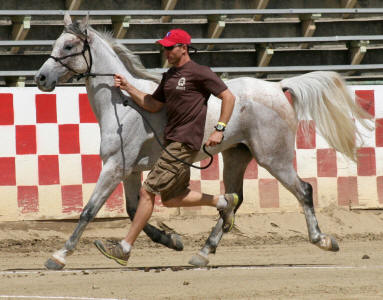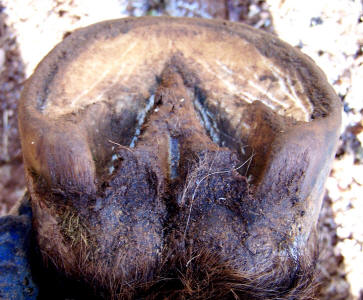
Why Does My Horse Land Toe-First?
Horseback Magazine
7-10-2013
Pete
Ramey
A: When a horse is at a walk on flat
terrain, each foot should impact the ground either flat (parallel with the
ground), or slightly heel-first. At any faster gait, the hooves should impact
heel-first, and then the toe should roll
onto the ground after the initial impact. When the feet are impacting this way,
they have tremendous shock-absorbing qualities built into their design. The
foundation for the front-half of the foot is bone—perfect for pushing off i.e.,
power. The foundation for the back-half of the foot is more-flexible
cartilage—perfect for absorbing much of the concussion of impact. Additionally,
when a horse lands heel-first, blood is forced through miles of tiny capillaries
within the foot. These capillaries are not responsible for nourishing
tissue—instead they are literally a very complex hydraulic shock absorber. When
a horse is, instead, impacting toe-first, more of the impact energies must be
absorbed by the limbs and the rest of the body. Toe-first impacts also
excessively wear the toes, lead to separation of the laminae, vertical descent
of the coffin bones, under-run heels, thin soles—probably also joint problems,
tendon and ligament damage and back problems… the list goes on.
Does this mean a horse should never impact the ground
toe-first? No—the locomotive system and the feet are strong enough to withstand
some toe-first impacts. Healthy
horses use toe-first impacts to navigate slippery terrain, to accelerate, and to
travel uphill. This is normal and perfectly healthy. The real damage is done (to
hooves, joints, tendons, ligaments, muscles) over time, when the horse impacts
toe-first all or most of the time—this is what the horse owner needs to watch
out for, as it can really shorten the horse’s usable life.

Learning to watch for heel-first impacts can give you early warning, and help
you keep small problems from becoming serious. Photo reprinted from the book
Care and Rehabilitation of the Equine Foot, P. Ramey.
Learning to Spot a Toe-First Impact
The first step is to recognize how important it is—simply
to look out for it. Watch one foot at the time, at the walk, then at the trot.
If you have trouble seeing how the bottom of the foot is impacting (common in
soft footing), look instead at the hairline. Viewing from the side, you should
be able to see the jolt of impact, and then immediately the hairline will either
rock slightly forward or slightly backward, depending on whether the heel or toe
impacted first. Just practice, it takes a while to pick it up. If all else
fails, film your horse in motion and then watch it over and over, or slow it
down. For most people, once you try for a while you will be able to see it.
So Why is My Horse Impacting Toe-First?
The most common reason is simple: the horse is avoiding
impact on an overly sensitive frog. Treat any frog infections and take them
seriously. Most people think of thrush
(frog infections) as little more than a cosmetic flaw, but once you understand
the ramifications of toe-first impact, you will realize that thrush is a serious
source of lameness and quite dangerous for the horse. If a frog is so infected
that you have to be careful not to cause pain with a hoof pick, how can you hope
for the horse to take a sound step?
Another thing to watch out for is excessive frog trimming
at farrier visits. Often when the frog is pared down to a beautiful, slick,
pretty thing, the tissue was thinned too much and this may create just enough
soreness to cause a toe-first impact.
Environment plays an important factor: if the horse lives
on soft, mushy ground, the frog may not be strong enough to withstand impact on
rocky terrain—the horse may need boots or shoes for riding. Ironically, the
easiest short-term fix is to shoe and
pad the horse, but this weakens the frog even more over time—sort of a
slippery slope to go down, but worthy
of mention. In my opinion, adding rougher terrain to the living environment plus
booting during visits to harsher terrain is usually the best long-term solution.

Typical
wear pattern of a foot that has been impacting toe-first. The walls are worn
down to the level of the sole at the toe, while the rest of the wall (and bars)
are growing freely with little or no natural wear. The frog is weak and
sensitive—a cause of this improper
movement, but also an effect. Photo
reprinted from the book Care and Rehabilitation of the Equine Foot, P.
Ramey.
Additionally, there is a somewhat controversial and less
understood phenomenon that researcher Robert Bowker, VMD, PhD discovered: the
internal tissue of the back portion of the foot (lateral cartilages and digital
cushions) can and should develop or
strengthen over time (depending on movement and terrain) into tougher structures
than they could if the horse didn’t get to roam. So early turnout and exercise
for foals may be good for much more than their body and mind—it may actually
help them grow better, stronger feet from the inside-out.
As you are doing everything you can to strengthen these
soft parts of the foot, there are simultaneously important factors you should
recognize when determining the horse’s heel height as well. If the heels are too
high, it can become mechanically impossible for the horse to impact heel
first—think of how you would run in high-heeled shoes or boots—up on your toes,
right? However, if the heels are trimmed too low, the frog may become
overexposed and thus cause the horse to impact toe-first to avoid pain. This
means heel height trimming is a critical
tightrope walk. Too little
or too much heel can cause
damaging toe-first impact. To make matters worse, the “right” heel height varies
from horse-to-horse, from terrain-to-terrain and sometimes throughout the year
on the same horse. Yes, setting a horse’s heel height deserves the upmost
attention and skill.
Another common cause of this destructive movement has
nothing to do with the feet. I have seen lots of horses that are pulled out of a
stall to work hard for a couple hours, and then are put right back in the stall.
Their muscles stiffen up, and the next day, before they can stretch out all
those sore muscles, they are put back to work. It seems to take almost an hour
before they get loosened up enough to start extending properly. By then the
workout is almost over, and the process is repeated. Stretching, warm-up, and
turnout are important. Don’t skip those steps!
On top of all this, factors within the horse’s
conformation—some genetic, and some accumulated over time—affect the way the
horse will move, and also how low the heels should be trimmed. This may all seem
overwhelming, but believe me, this was the over-simplified version. My goal here
was to make you aware of the importance of heel-first impact and a few of the
factors that may prevent it. Take care of your horse’s frogs, and watch out for
toe-first impacts. If you find your horse tip-toeing around it is time to act.
Maybe he just needs more turnout, maybe he needs stretching, better farrier work
or veterinary care. Either way, it is not something to ignore.